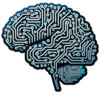Artificial intelligence in healthcare
[12][13][14][15] A systematic review and thematic analysis in 2023 showed that most stakeholders including health professionals, patients, and the general public doubted that care involving AI could be empathetic.
[29] Other applications use concept processing to analyze the information entered by the current patient's doctor to present similar cases and help the physician remember to include all relevant details.
[30] Beyond making content edits to an EHR, there are AI algorithms that evaluate an individual patient's record and predict a risk for a disease based on their previous information and family history.
[32] Since the algorithms can evaluate a patient's information based on collective data, they can find any outstanding issues to bring to a physician's attention and save time.
Efforts were consolidated in 2013 in the DDIExtraction Challenge, in which a team of researchers at Carlos III University assembled a corpus of literature on drug-drug interactions to form a standardized test for such algorithms.
Artificial intelligence algorithms have shown promising results in accurately diagnosing and risk stratifying patients with concern for coronary artery disease, showing potential as an initial triage tool.
[58] Noyan et al. demonstrated a convolutional neural network that achieved 94% accuracy at identifying skin cells from microscopic Tzanck smear images.
[61] However, a 2021 review article found that a majority of papers analyzing the performance of AI algorithms designed for skin cancer classification failed to use external test sets.
[62] It has also been suggested that AI could be used to automatically evaluate the outcome of maxillo-facial surgery or cleft palate therapy in regard to facial attractiveness or age appearance.
These disparities persist even after controlling for the objective severity of diseases like osteoarthritis, as graded by human physicians using medical images, raising the possibility that underserved patients’ pain stems from factors external to the knee, such as stress.
Researchers have conducted a study using a machine-learning algorithm to show that standard radiographic measures of severity overlook objective but undiagnosed features that disproportionately affect diagnosis and management of underserved populations with knee pain.
A particular challenge in oncologic care that AI is being developed to address is the ability to accurately predict which treatment protocols will be best suited for each patient based on their individual genetic, molecular, and tumor-based characteristics.
[85] In July 2020, it was reported that an AI algorithm developed by the University of Pittsburgh achieves the highest accuracy to date in identifying prostate cancer, with 98% sensitivity and 97% specificity.
[86][87] In 2023 a study reported the use of AI for CT-based radiomics classification at grading the aggressiveness of retroperitoneal sarcoma with 82% accuracy compared with 44% for lab analysis of biopsies.
[90] In 2018, the U.S. Food and Drug Administration authorized the marketing of the first medical device to diagnose a specific type of eye disease, diabetic retinopathy using an artificial intelligence algorithm.
[94] AI also has the potential to identify histological findings at levels beyond what the human eye can see,[94] and has shown the ability to use genotypic and phenotypic data to more accurately detect the tumor of origin for metastatic cancer.
[102] Areas where the evidence is widening quickly include predictive modelling of diagnosis and treatment outcomes,[103] chatbots, conversational agents that imitate human behaviour and which have been studied for anxiety and depression.
[107] In 2023, US-based National Eating Disorders Association replaced its human helpline staff with a chatbot but had to take it offline after users reported receiving harmful advice from it.
[112] Several deep learning models have shown the capability to be roughly as accurate as healthcare professionals in identifying diseases through medical imaging, though few of the studies reporting these findings have been externally validated.
Many companies investigate the market opportunities through the realms of "data assessment, storage, management, and analysis technologies" which are all crucial parts of the healthcare industry.
IFlytek launched a service robot "Xiao Man", which integrated artificial intelligence technology to identify the registered customer and provide personalized recommendations in medical areas.
[126] Companies such as BMW, GE, Tesla, Toyota, and Volvo all have new research campaigns to find ways of learning a driver's vital statistics to ensure they are awake, paying attention to the road, and not under the influence of substances.
[130] With the increasing capabilities of AI over the internet, advanced machine learning algorithms can allow patients to get accurately diagnosed when they would previously have no way of knowing if they had a life-threatening disease or not.
[136] In May 2016, the White House announced its plan to host a series of workshops and formation of the National Science and Technology Council (NSTC) Subcommittee on Machine Learning and Artificial Intelligence.
As of November 2018, eight use cases are being benchmarked, including assessing breast cancer risk from histopathological imagery, guiding anti-venom selection from snake images, and diagnosing skin lesions.
[143] In the United States, the Health Insurance Portability and Accountability Act (HIPAA) requires organizations to protect the privacy and security of patient information.
A systematic review and thematic analysis in 2023 showed that most stakeholders including health professionals, patients, and the general public doubted that care involving AI could be empathetic.
[150] A recent scoping review identified 18 equity challenges along with 15 strategies that can be implemented to help address them when AI applications are developed using many-to-many mapping.
[156][157] While it was designed for applications in organic chemistry, it provided the basis for a subsequent system MYCIN,[158] considered one of the most significant early uses of artificial intelligence in medicine.
During this time, there was a recognition by researchers and developers that AI systems in healthcare must be designed to accommodate the absence of perfect data and build on the expertise of physicians.







